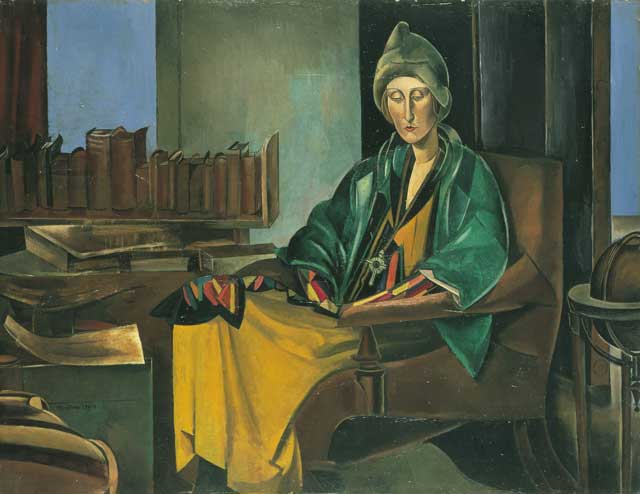Great Works: Edith Sitwell(1923-35), Wyndham Lewis
Tate, London

Your support helps us to tell the story
From reproductive rights to climate change to Big Tech, The Independent is on the ground when the story is developing. Whether it's investigating the financials of Elon Musk's pro-Trump PAC or producing our latest documentary, 'The A Word', which shines a light on the American women fighting for reproductive rights, we know how important it is to parse out the facts from the messaging.
At such a critical moment in US history, we need reporters on the ground. Your donation allows us to keep sending journalists to speak to both sides of the story.
The Independent is trusted by Americans across the entire political spectrum. And unlike many other quality news outlets, we choose not to lock Americans out of our reporting and analysis with paywalls. We believe quality journalism should be available to everyone, paid for by those who can afford it.
Your support makes all the difference.The best portraits – though seldom those that are commissioned by the sitter for large sums of money – are often the most preposterous. Wyndham Lewis's great portrait of the gloriously colourful poet Edith Sitwell was painted over a period of about 12 years, between 1923 and 1935. The painter had to do a moonlight flit from his studio in October 1923 in order to avoid creditors. At that point the portrait had a head; legs, coat and chair were well under way, too. Twelve years later, Wyndham Lewis gave it a conclusion of sorts.
It is a portrait that both reveals and partially disguises Lewis's attitude towards Dame Edith herself. He both loved and loathed her. Lewis himself was a mercilessly watchful observer of human foibles, and a deeply flawed human being – he once described Hitler as a " man of peace".
The painting looks almost pyramidal in shape because our eyes constantly return, rising up and up, to the way in which Lewis has painted the head and the pointed hat – all is thin and long and stretched. The heavily lidded eyes are closed, which suggests that the Dame is in a meditative mood, ruminating upon yet more deathless lines of verse, which will soon come showering – like so much spilled blood – from her tireless pen. Curiously, her arms appear not to culminate in hands. Why no hands? Their absence rather suggests that what we have taken for arms are in fact a pair of carefully folded wings. In fact, the decorous garment she is wearing, and the way it culminates in those panellings of colourful rectangles, looks very like a bird's plumage, which again wings us back to the possibility of the painting's subject's being borne aloft on the deathless wings of poesy, as John Keats once wrote with exquisitely tenderised sugariness.
And yet in spite of the fact that the human creature under scrutiny here looks taut, pent, almost squawkily bird-like, it also looks faintly mechanised, faceted by the severity of the geometry of its lines. So if Dame Edith is indeed a bird of sorts, she is undoubtedly a mechanised bird – rather like those war planes that had so recently been menacing the skies. So she is both serene, cool and Buddhistically withdrawn from us, and malignly capable of doing harm when not at rest. All of which contrasts violently with how she is dressed, which speaks of a degree of self-display that seems to be pushing itself to the point of absurdity. So there is a ridiculous contrast at work here between the sage (or mandarin-like withdrawal to be found in the stonily withdrawn facial expression – the angle of the eyes seems to suggest that she might be reading, but the missing hands hold no absent books) and the theatrical display of her costuming: the lower reaches of that splashy yellow dress, for example, and the way it seems to be upheld, rather tautly, by her knees, make it look a bit like a carelessly thrown theatre drape...
Great portraits down the centuries generally show us the sitter in the company of objects of great symbolic importance to them. And so it is here. There is such culture at Dame Edith's elbow, so many fat, brown books; in fact, so many that they appear to be driving the top shelf of the to the limit, causing it to teeter alarmingly over an abyss of space. There is such cultural gravitas in those books – and in the large globe on its stand, which is to the left (your right) of Dame Edith's chair.
All that I am shall endure forever, incantates Dame Edith. Pull the other one, retorts Lewis, her mockingly vengeful portraitist.
ABOUT THE ARTIST
Wyndham Lewis (1882-1957) was a prodigiously talented Modernist painter, novelist, polemicist and art critic of the first half of the 20th century. His portraits are some of his greatest works. He painted his eminent literary contemporaries - Naomi Mitchison, T S. Eliot, Stephen Spender and Ezra Pound - with a cold and merciless eye. The painter Walter Sickert once described him as the greatest portraitist of this or any other generation.
Join our commenting forum
Join thought-provoking conversations, follow other Independent readers and see their replies
Comments